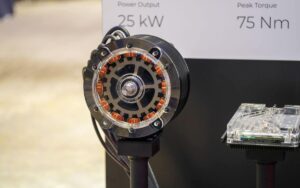Enedym will use the Honda investment to scale up production to meet growing demand for low-cost electric motors

The biggest challenge with electric motors today is high costs, driven largely by permanent-magnet designs that depend on rare earth metal. Enedym’s switched reluctance motor is the potential solution to those cost hurdles. Photo: Enedym
Enedym will use the Honda investment to scale up production to meet growing demand for low-cost electric motors
Enedym, a Hamilton, Ont.-based technology company, has secured a strategic investment from Honda Motor Co. to accelerate the development of its rare-earth-free electric motor technology and ramp up operations.
The funding comes through Honda Xcelerator Ventures, the Japanese automaker’s global open innovation program.
“We started working with Honda about a year ago, and we are very happy that they made the investment,” says Ali Emadi, founder, president, and CEO of Enedym, in an interview with Electric Autonomy. “What it means for Enedym is that it is really important for us, as a startup company, to have the support and collaboration of a massive global OEM.”
Enedym specializes in switched reluctance motors (SRMs). This type of electric motor has historically suffered from noise, low torque density and poor efficiency, making it hard to compete with permanent magnet motors.
“We have solved those [issues],” says Emadi. “Our motors are quiet, our motors compete very effectively.”
For Emadi, Honda’s investment is a “validation” of a technology that many have dismissed for years. It also comes at a moment of growing pressure to find alternatives to rare earths, which dominate today’s EV motors.
“Most electric propulsion motors today use permanent magnets made from rare earth metals, which are expensive and environmentally challenging,” says Manabu Ozawa, managing executive officer of Honda Motor Co., in a press statement. “Enedym motors do not use any permanent magnets, and Honda has high hopes for its potential.”
Growing demand for motors
Enedym emerged from nearly a decade of research at McMaster University’s McMaster Automotive Resource Centre (MARC), spinning out in 2018 to commercialize its electric motor technology.
Electric motors are “the driving force behind the modern world,” used in everything from home appliances to air conditioning systems, door openers and in industrial factories. Particularly in electrified transportation, they are “the beating heart of the [vehicle] propulsion,” says Emadi.
The biggest challenge with electric motors is high costs, driven largely by permanent-magnet designs that depend on rare earth elements such as neodymium and dysprosium.
These materials are expensive, heavily concentrated in China and require energy-intensive, often radioactive processing. In some motors, Emadi points out, magnets make up “40 to 50 per cent” of the total cost.
Building new rare-earth mines or processing plants in North America is one option, says Emadi, but it’s expensive and slow.
“We need alternatives,” says Emadi. “[We] need to push the limitations in technology and innovation to bring the cost down.”
Enedym’s answer is its SRM solution, which eliminates magnets altogether and uses only electrical steel, copper and iron.
“Our motors are simple and low cost,” says Emadi. The motors don’t rely on fragile supply chains, can handle higher temperatures and harsher environments, and avoid demagnetization issues that can occur with permanent-magnet designs.
Additionally, Enedym pairs its hardware innovation with a comprehensive digitization software platform that is multi-objective, multi-domain, multi-physics and artificial-intelligence-enabled design.
The platform allows Enedym to rapidly design, optimize and prototype new motors.
“We design electric motors at a fraction of the time and cost than anybody else,” says Emadi. “This combination is a tremendous IP [intellectual property] on motors, tremendous IP on digitization, and we can go after multiple markets.”
Early deployments and steady scaling
Enedym’s motors are already undergoing trials in several real-world environments.
In May 2024, an all-electric Toyota luggage tugger powered by Enedym’s rare-earth metal-free propulsion system was piloted at the Hamilton airport, in partnership with Toyota Tsusho Canada. The startup’s technology is also being tested at Toyota’s facility in Texas and at other airports, including Atlanta, where SRM-powered tractors log 18-hour shifts per day.
“Reliability, reliability, reliability — that’s so important,” says Emadi. “We’re a lot more cautious than typical startups because this is hard tech. We want to make sure that everything works really well.”
The Honda investment will support expansion, but growth will remain measured. “This [investment] is very helpful to help us go faster and better,” says Emadi. “But we’re not going to ramp up too fast. Nothing fails like success — we want to grow sustainably.”
The next major milestone Emadi is looking forward to is scaling production at Enedym FARM (facility for advanced rapid manufacturing), where the company designs, develops, prototypes and tests its technology and works with strategic partners.
“We are aiming within the next 12 months to get to capacities of over a thousand units, manufactured in Hamilton,” he says, with higher volumes targeted within two years and vehicle demonstrations underway.






